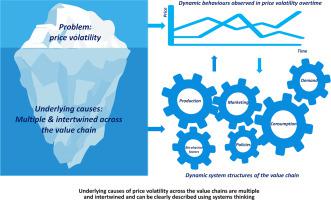Agricultural Systems ( IF 6.6 ) Pub Date : 2021-05-26 , DOI: 10.1016/j.agsy.2021.103179 Y.N. Muflikh , C. Smith , C. Brown , A.A. Aziz

|
CONTEXT
High price volatility in agricultural commodities can be a major issue for value chain actors exposed to its adverse economic impacts. Price volatility results from the interaction of multiple factors linked within dynamic and complex agricultural systems. Therefore, to address price volatility, the approach needs to be capable of analysing feedback that occurs in such complex systems.
OBJECTIVE
We integrate a systems thinking approach and value chain analysis to overcome the constraint of other methods to explicitly describe and understand how system structure influences system behaviour observed in price volatility and the assessment of the consequences of ex-ante and ex-post policy interventions based on this understanding.
METHODS
The proposed integrated approach involves the active participation of value chain actors and stakeholders to improve their understanding of the complex systems they operate within including the policy environment. The approach takes the Indonesian chilli value chain as a case study. We implemented the first two steps of systems thinking (i.e., articulating problems and formulating dynamic hypotheses). In the group model building processes, we developed causal loop diagrams to represent a dynamic hypothesis that explains the feedback loops that cause price oscillation behaviour and systems archetypes that identify potential intervention points.
RESULTS and CONCLUSIONS
The integrated approach was able to link the Indonesian chilli value chain's system structure and the system behaviour observed in price volatility. The causal loop diagram clearly displays the feedback between production, market governance, consumption, and price. The diagram also portrays how these factors impact value chain actors' performance and the influence of time delays and random shocks on the entire value chain system. Limits to growth and shifting the burden archetypes were identified as critical leverage points in formulating fundamental policy interventions to address price volatility.
SIGNIFICANCE
This study demonstrates the strengths of the proposed approach in developing a comprehensive dynamic qualitative model of a whole value chain system that influences the system behaviour, such as oscillation, which other modelling studies do not consider. The use of system archetypes to identify intervention points is another research contribution in that it improves value chain analysis. The results also highlight the benefits of participatory system dynamics modelling in enhancing the learning of value chain actors in anticipating the consequences of any actions or random shocks on the entire systems.
中文翻译:

使用系统思维分析农业价值链中的价格波动:以印度尼西亚辣椒价值链为例
语境
对于遭受不利经济影响的价值链参与者而言,农产品的高价格波动可能是一个主要问题。价格波动是由动态和复杂的农业系统中相互联系的多个因素相互作用而造成的。因此,为了解决价格波动的问题,该方法必须能够分析这种复杂系统中发生的反馈。
客观的
我们将系统思考方法和价值链分析相结合,以克服其他方法的约束,从而明确描述和理解系统结构如何影响价格波动中观察到的系统行为以及基于此评估事前和事后政策干预的后果这种理解。
方法
拟议的综合方法涉及价值链参与者和利益相关者的积极参与,以增进他们对包括政策环境在内的复杂系统的理解。该方法以印尼辣椒价值链为案例研究。我们实施了系统思考的前两个步骤(即,阐明问题和制定动态假设)。在组模型构建过程中,我们开发了因果关系图来表示一个动态假设,该因果图解释了导致价格波动行为的反馈环和识别潜在干预点的系统原型。
结果与结论
集成方法能够将印尼辣椒价值链的系统结构与价格波动中观察到的系统行为联系起来。因果关系图清楚地显示了生产,市场治理,消费和价格之间的反馈。该图还描绘了这些因素如何影响价值链参与者的绩效,以及时间延迟和随机冲击对整个价值链系统的影响。在制定解决价格波动的基本政策干预措施时,限制增长和改变负担原型是关键的杠杆点。
意义
这项研究证明了该方法在开发影响整个系统行为(例如振荡)的整个价值链系统的综合动态定性模型中的优势,而其他建模研究则不考虑这种方法。使用系统原型识别干预点是另一项研究贡献,因为它改善了价值链分析。结果还突出了参与式系统动力学模型在增强价值链参与者的学习方面的优势,从而可以预测任何行为或随机冲击对整个系统的后果。



























 京公网安备 11010802027423号
京公网安备 11010802027423号